
Best road bike wheels 2025: disc and rim wheelsets to supercharge your ride, reviewed and rated
Our complete guide to what to look for in the best road bike wheels, including the type of rim, the material, and the depth you should go for
One surefire way to unlock performance in your road bike is with a new set of the best road bike wheels. Often, in an area where the majority of bike manufacturers economise to meet a price point, even the best road bikes won’t be meeting their full potential.
Recent developments in materials technology have unlocked previously impossible freedoms within wheel engineering. Disc brakes and the wide adoption of the best tubeless tyres have been a significant catalyst for this leap forward in wheel performance.
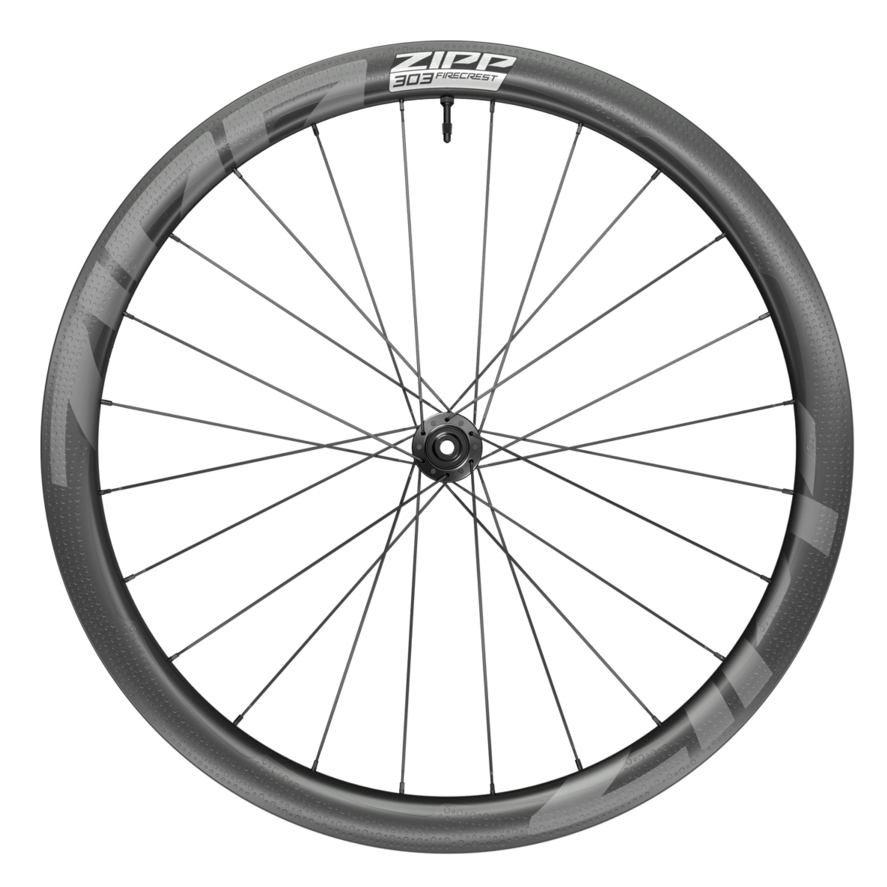
Lightweight, stiff, fast-rolling wheels, well-suited to varied terrain. Hookless rims do need compatible tyres, though.
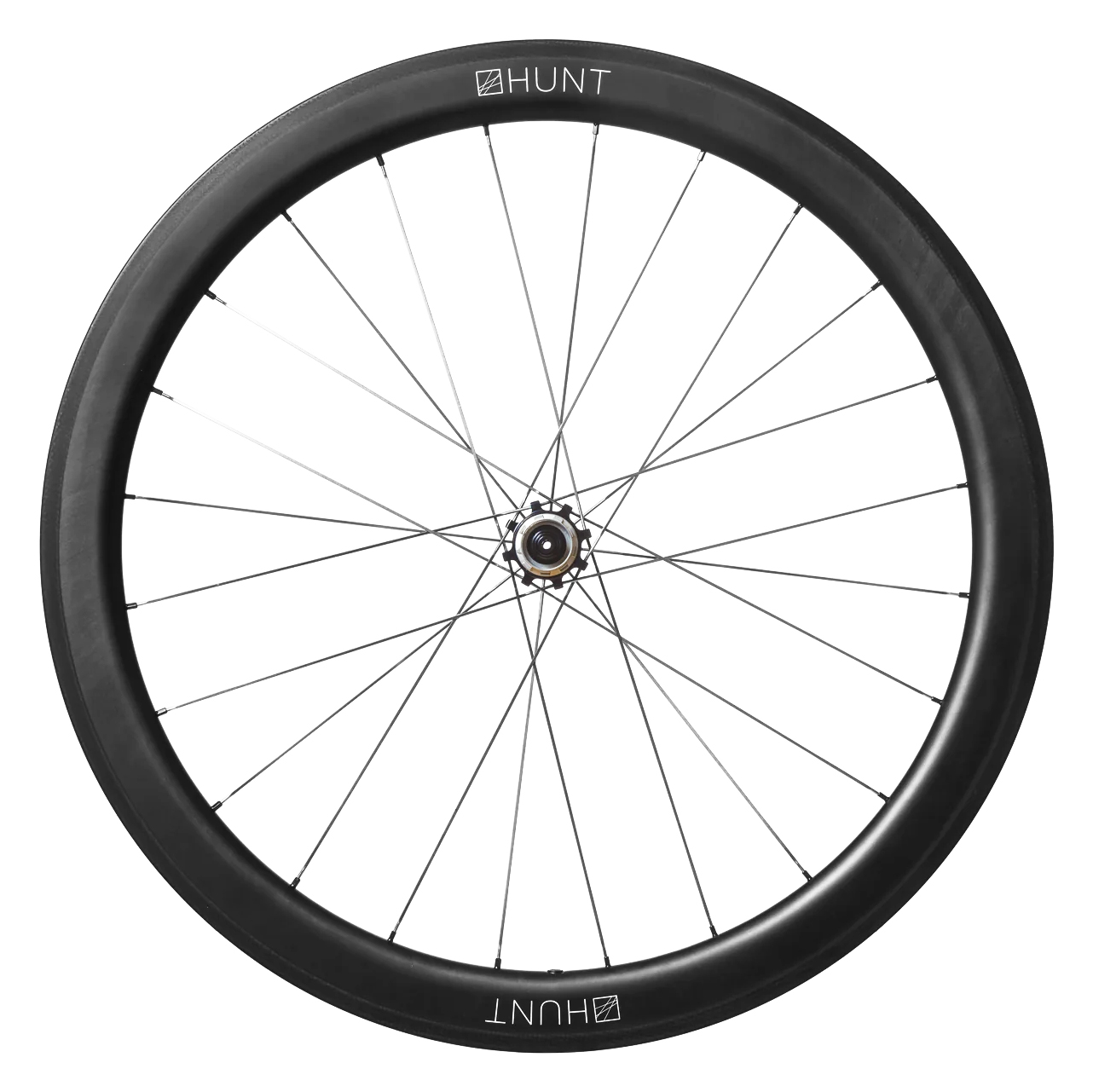
Competitively priced aero rim brake wheels that are unstoppable once you have them moving. Wide internal rim widths and tubeless-ready make for great tyre compatibility.
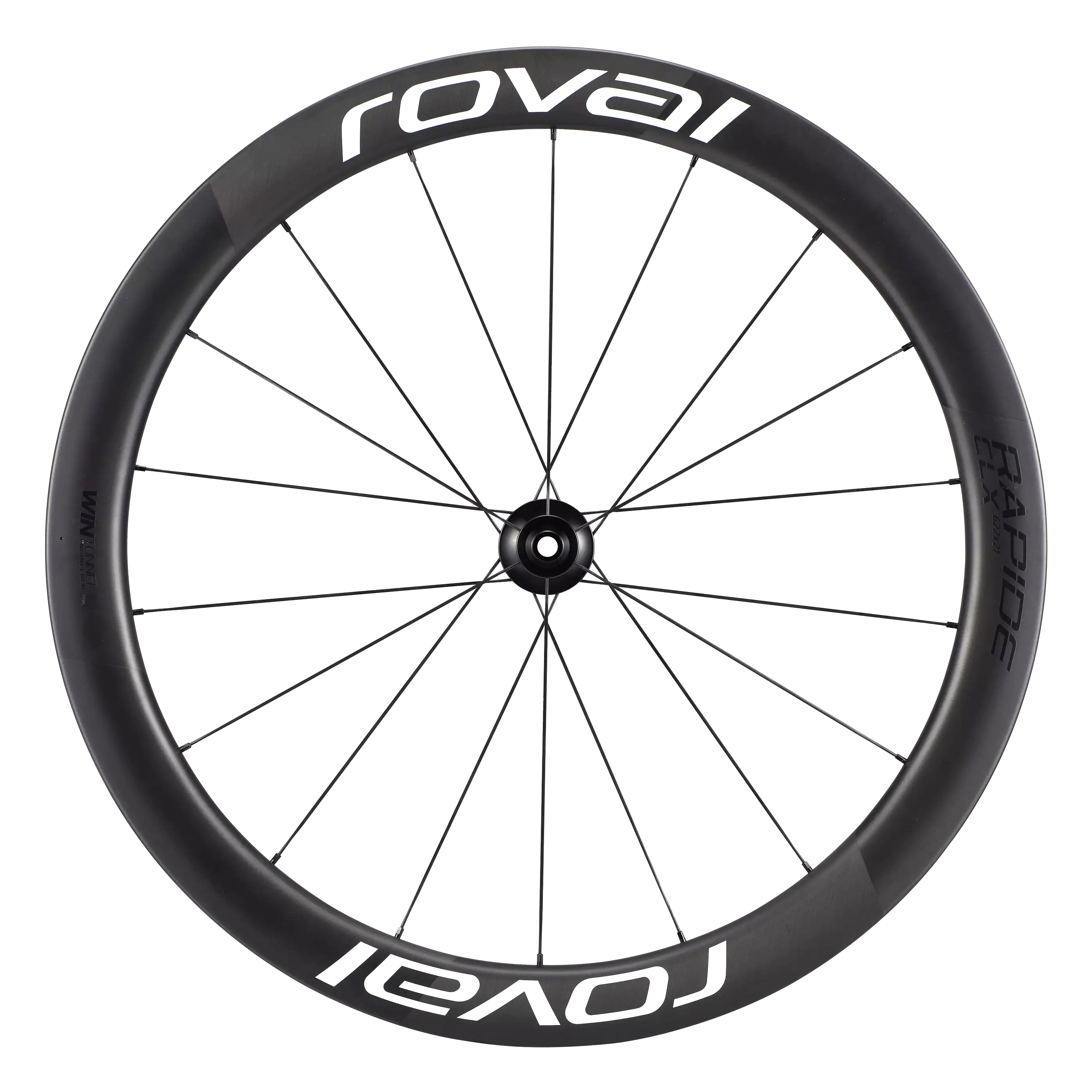
The whole point of the Rapide CLX II is to handle winds; however, there is always a fear that a wheel with such a high price tag might miss the mark. That is just not the case with Rovals. They are exceptional wheels to ride.
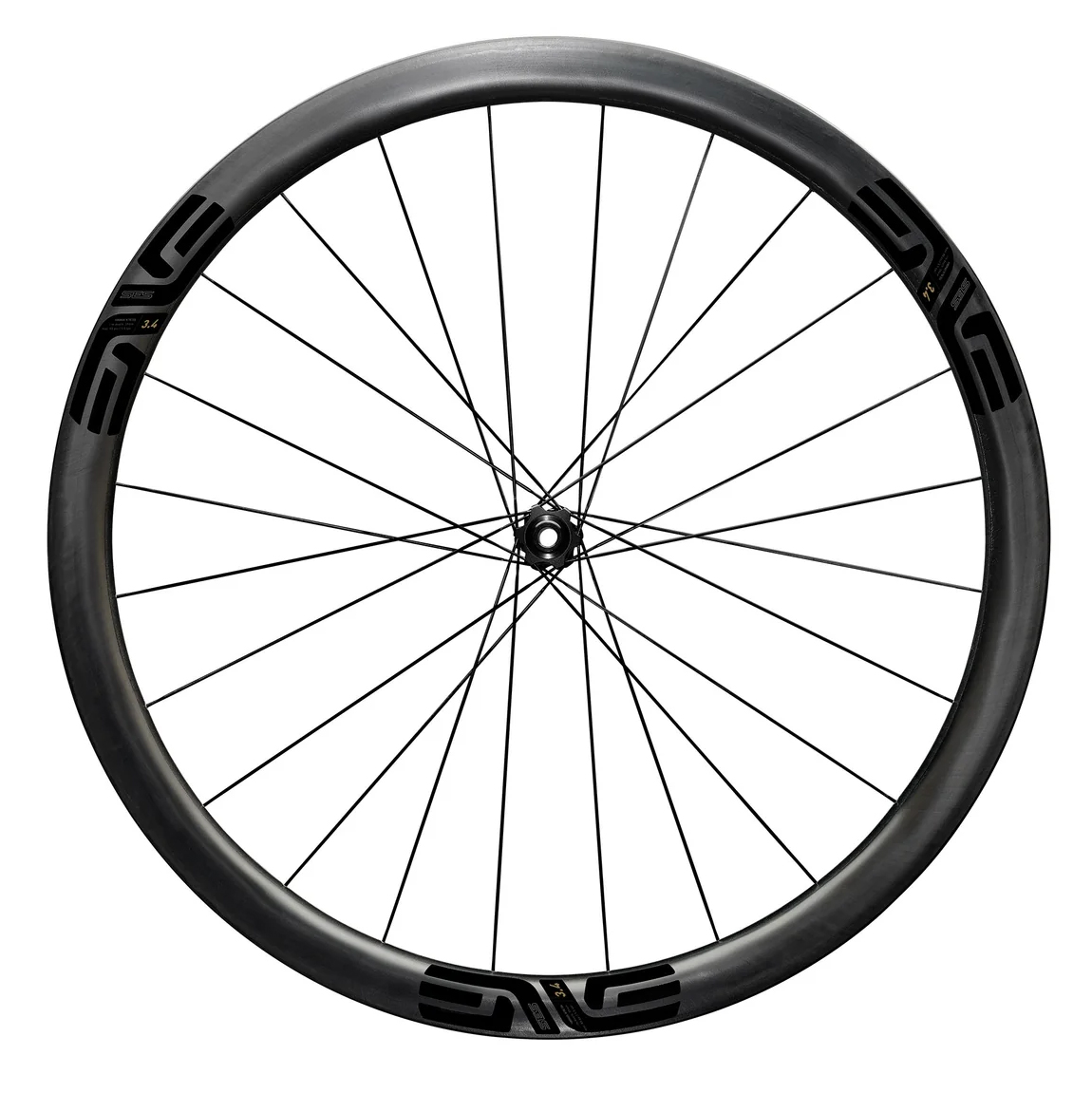
Weighing under 1,400g, these are a high-quality, lightweight all-rounder, but expect to find a price tag to match.

Giving a wheelset five stars speaks for itself. The Rondo wheels from Parcours are an excellent set of all-round wheels that feature aerodynamics but more importantly a strong build and the ability to fit wider tyres.

There is no arguing with a full carbon 50mm deep wheelset that only weighs 1433 grams and is under £700. Scribe backs up this value with an honest, no gimmicks, and over-delivering on performance for the price.
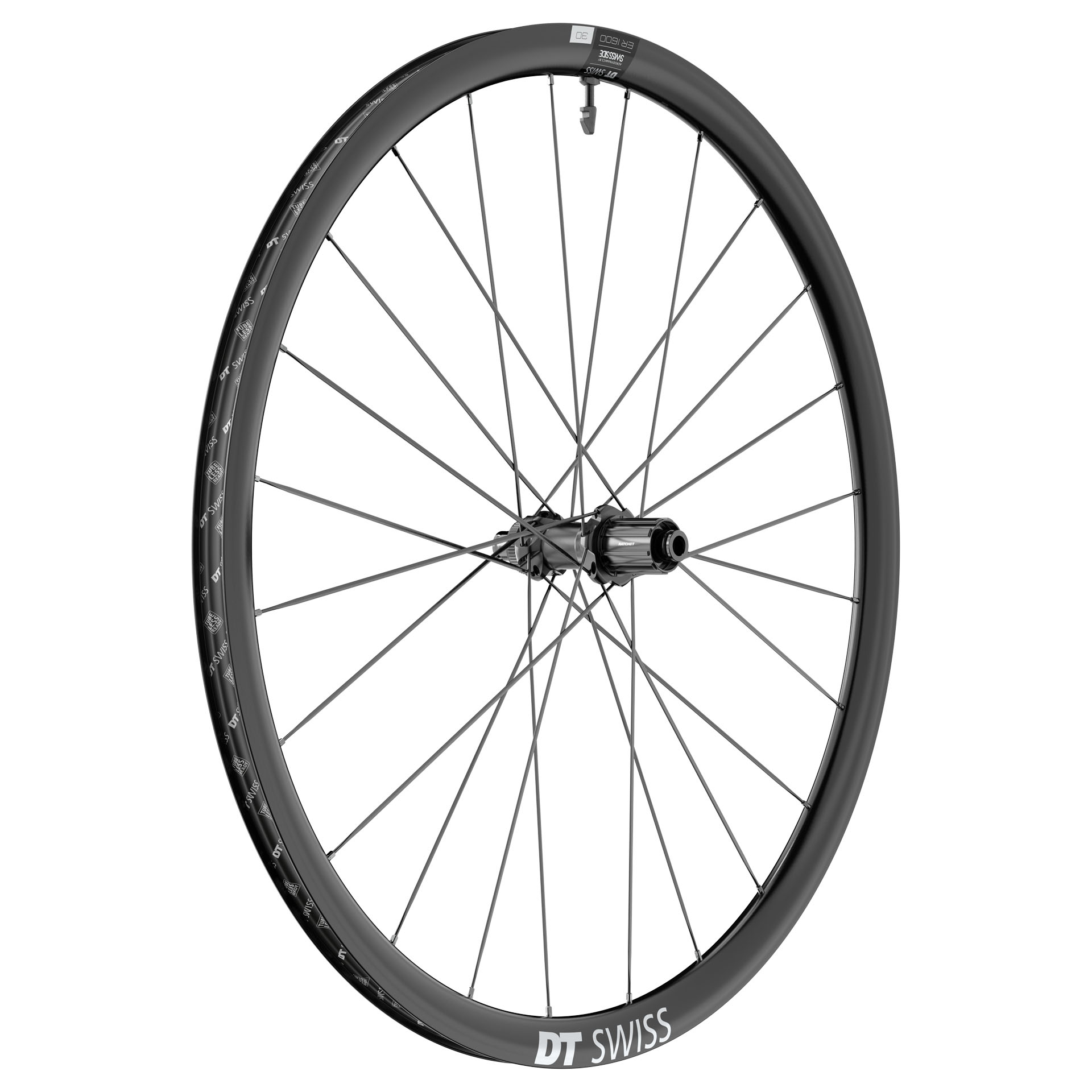
While shallow, aluminium wheels lack visual appeal, the DT Swiss ER 1600 Spline 23 certainly don't lack performance. For an inexpensive wheel, they feature DT Swiss's 350 ratchet hub design and excellent ride feel.
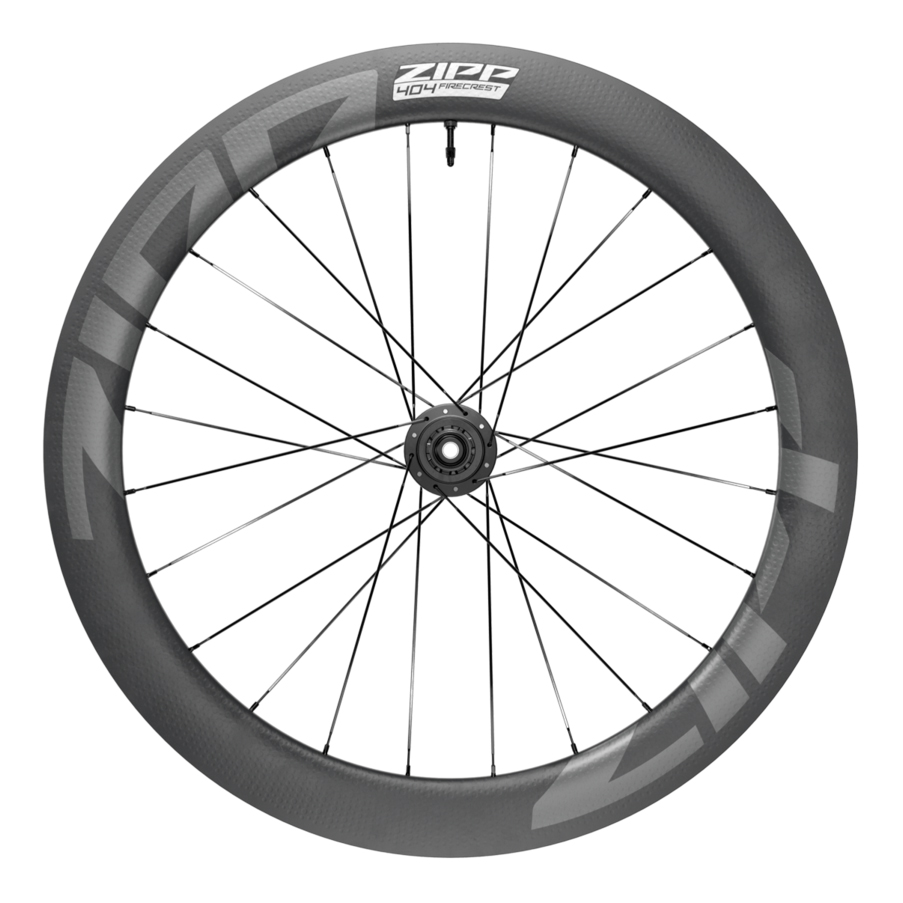
The 404s hit a sweet spot between price and performance, proving incredibly agile and responsive for a wheel nearly 60mm in depth.
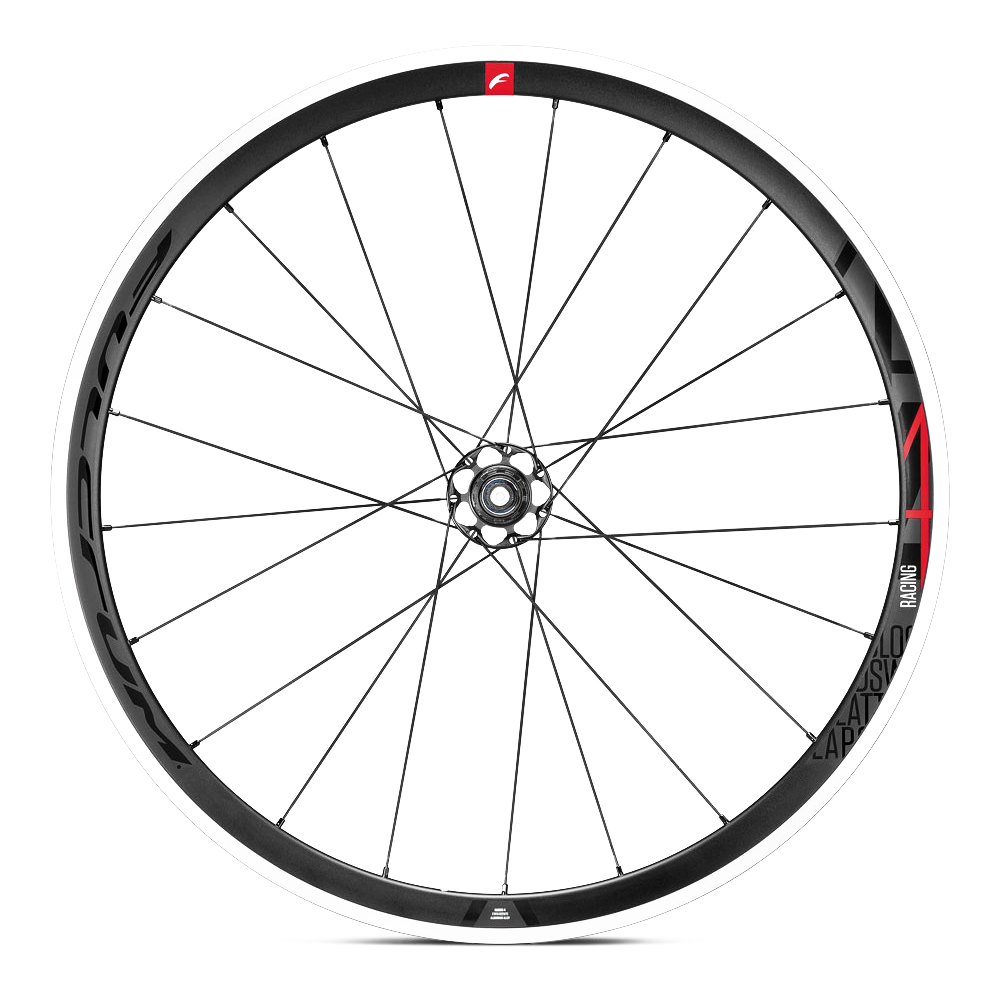
In a world of superfast carbon disc brake wheels, it is hard to get excited about alloy rim brake wheels. For those still rocking rim brakes, the Fulcrum racing 4s are a decent and solid choice.
Loads three more of the best road bike wheels
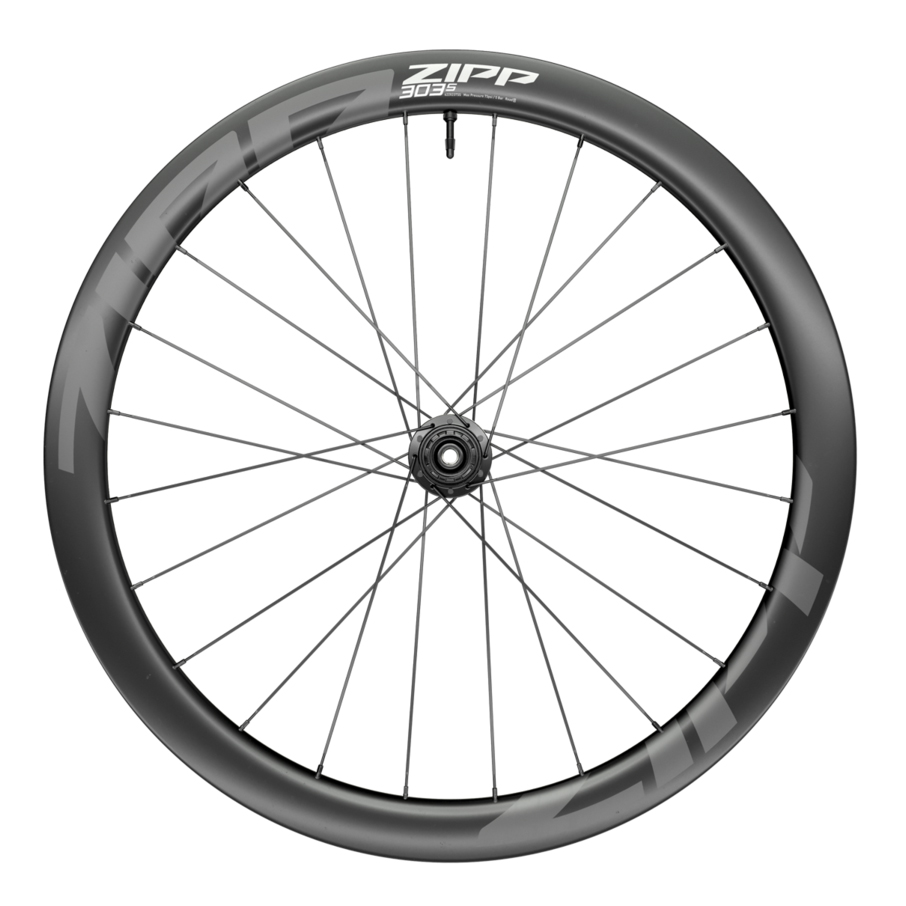
With all the aerodynamic performance and innovation Zipp offers, it naturally comes with a higher cost. So, the fact that you can get some of that Zipp performance regularly for under £1000/$1400 with the 303S makes them worth the consideration.
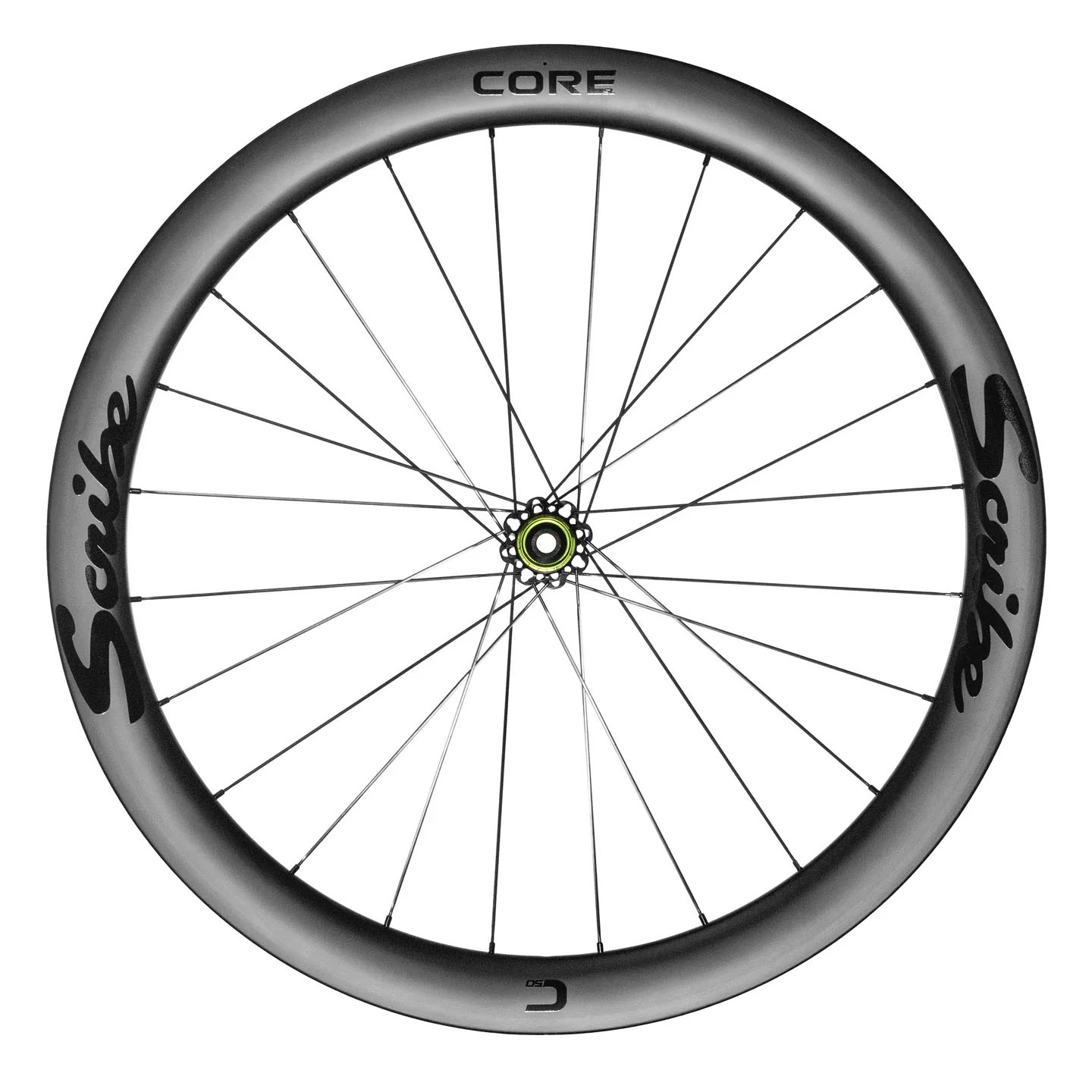
The Core SL+ 50 hits a very desirable sweet spot between the momentum-holding abilities of heavier, deeper wheels and the responsiveness of very light, shallower rims. Factor in that they are stunning value, and I was left wondering if there was any wheel that could compete?
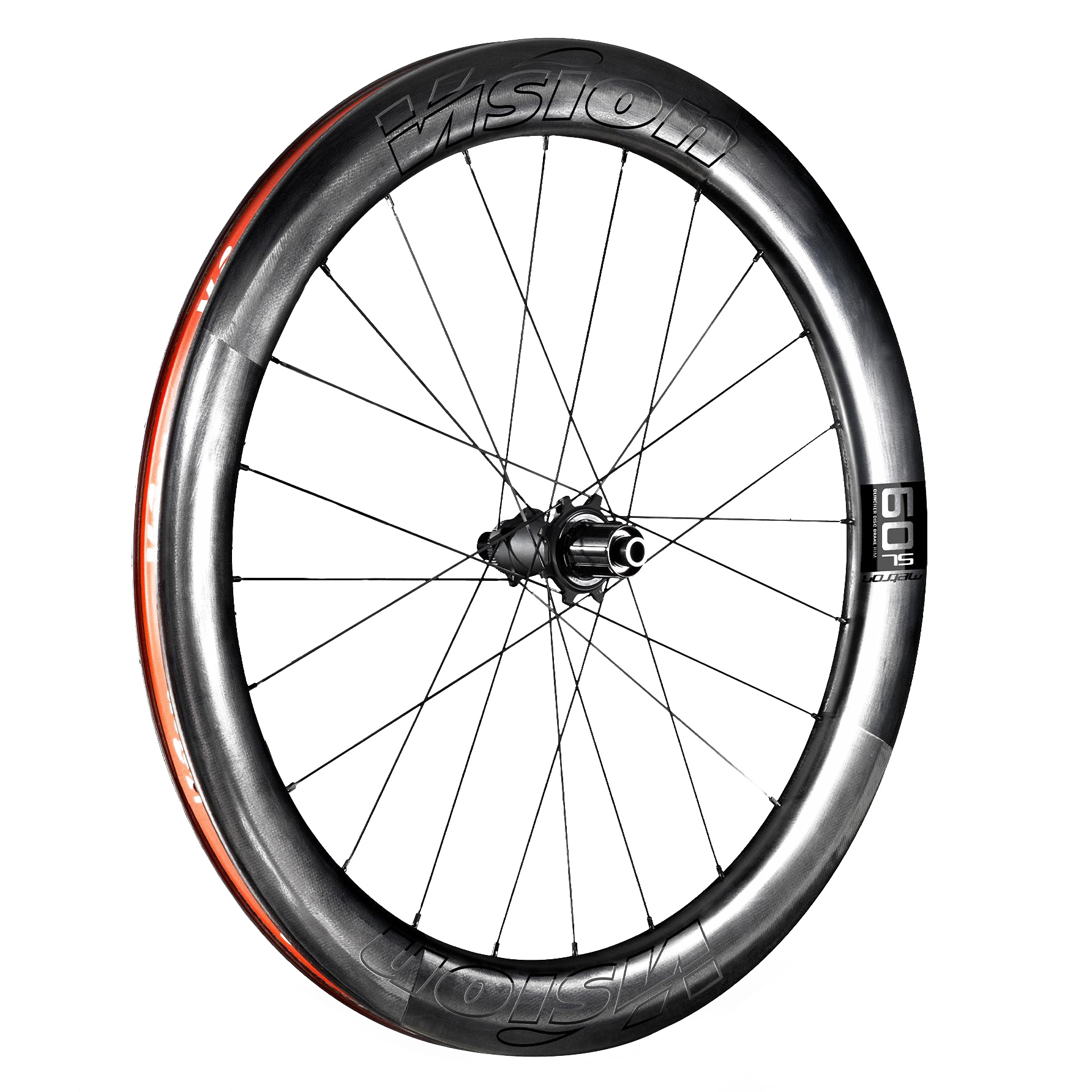
Testing the Metron Sl 60s was a rollercoaster ride, with the wheels impressing me in some areas and leaving me wanting more in others. What can't be denied is that they are stiff, which helps them handle well and perform exceptionally in the wind.
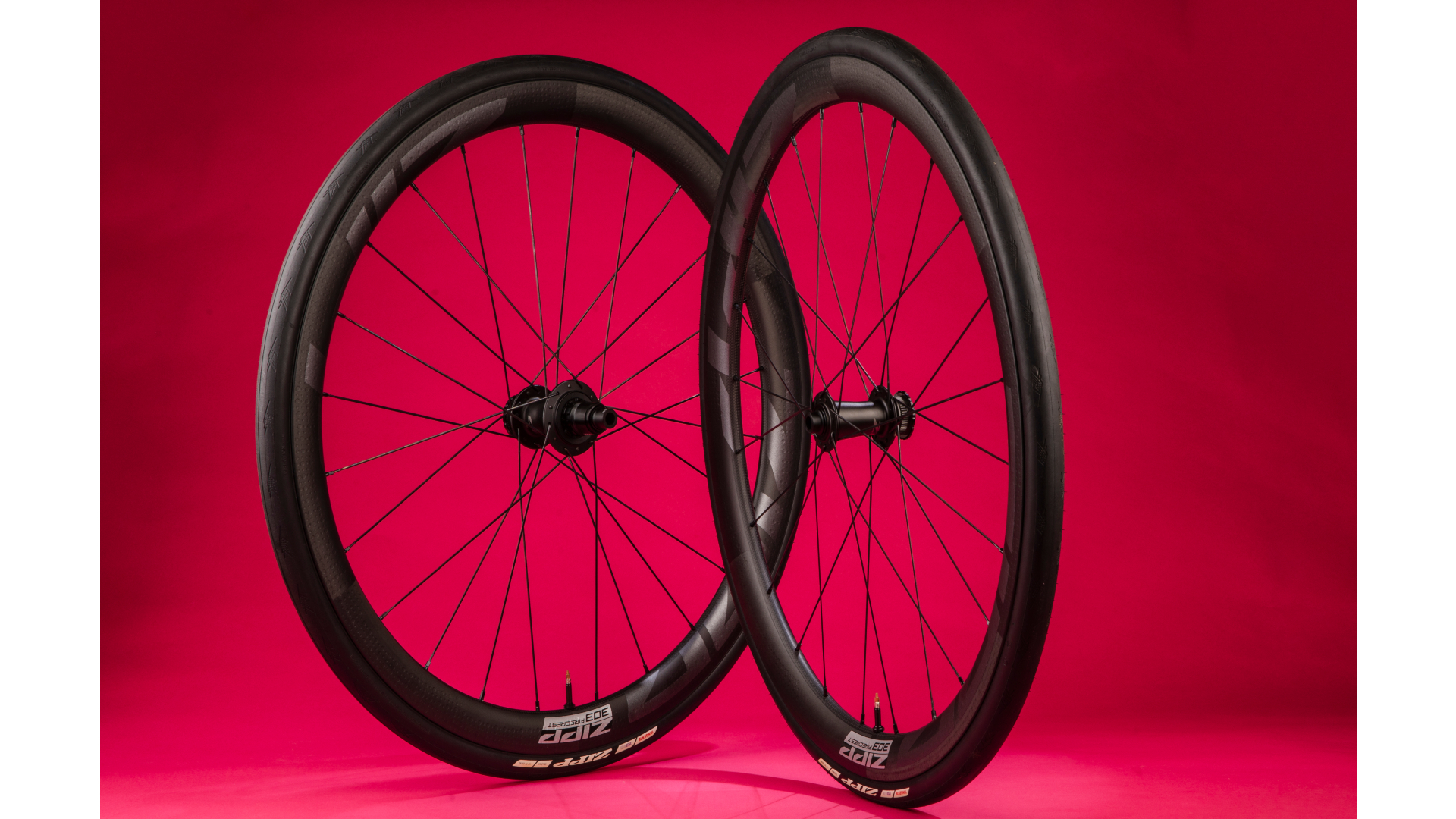
Our expert review:
Zipp's current focus is on producing wheels designed to be run with wide, tubeless tires and at lower pressures. These are hookless rims with a 25mm internal width, so need to be run with rubber over 28mm and below 72psi.
The hookless set up does mean you are slightly limited on the tires which you can use, be we found the ride quality absolutely excellent, with these being one of the best you can currently buy - so we'd very happily accept that slightly narrower choice of tires for the benefits it brings.
The lower tire pressure requirement does deliver a softer ride feel - not to be confused with a slower one. The smoother ride delivers an almost blood like connection with your bike, coupled with the broader rim profile, allows for impressively balanced and confidence inspiring on bike capabilities. In fact, on test, we were able to hit 85km/h and they didn't once so much as give a tiny flutter, even in some gusty wind conditions.
A low rolling weight and a 66 point engagement hub also means these pick up fast and are capable of showing a clean pair of heels in any sprint.
Popping a set of Tangente Course G40 tires gravel tires on the rim the wheels really came into their own. Capable of taking up to 50mm tires and, over a 400km three day adventure, they only lost around 2psi.
Read our full Zipp 303 Firecrest Carbon road bike wheelset review
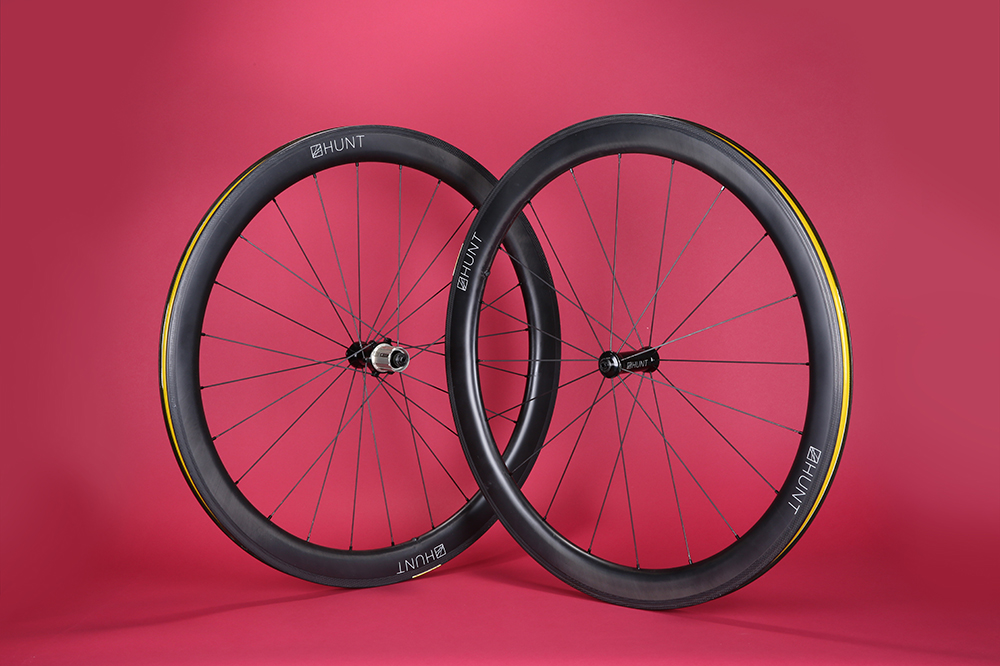
Our expert review:
This performance wheelset is particularly important at what is probably the most competitive price point on the market. They're not the fastest to accelerate because they're 50mm deep, but once the Hunt 50 Carbon Wide Aero wheels are up to speed they're unstoppable and on our tests, these instantly increased our average ride speed.
As ever with Hunt wheels, they're tubeless-ready and have a very wide rim width because of it. Whichever tires you put on it will sit far wider than their stated widths.
Read our full Hunt 50 Carbon Wide Aero review

Our expert review:
The Roval Rapide CLX II feature asymmetric rims, with the front being 51mm deep with a 35mm external width, while the rear is 60mm deep with a 30.7mm external width. Both feature a 21mm internal width. The wheels feature DT Swiss’s 180 hub internals with ceramic bearings and the Ratchet EXP 36 teeth freehub for 10 degrees of engagement. Our scales read 1,515g.
The idea here is to improve handling in crosswinds, as well as optimise aero performance where the front and rear wheels experience different practical wind angles, with the front experiencing higher yaw angles than the rear.
Out on the road, it is noticeable how stable these wheels perform in windy conditions, with the front never feeling at risk of being swept across. I was comfortable enough to remove and put on a jacket, even in blustery conditions. The wheels also felt like they flew across the flats, rolling road and descents with ease, more akin to a deeper wheelset. The low weight also helped with accelerations both on the flat and on the climbs.
The spoke lacing pattern likely contributes to this torsional stiffness when accelerating, as the rear drive side uses 2-cross 16-spoke lacing, while the rotor side features the same pattern but 8 spokes. The front wheel is radial on the drive side with 1-cross on the rotor side. Although it exhibited good lateral stiffness for cornering, the front was a little delayed under heavy braking with less torsional stiffness.
Something everyone will notice is how hard it was to fit the tyres. These were some of the toughest wheels to mount the Pirelli P Zero RS Race 28mm TLRs on. With such a high price, these wheels needed to perform exceptionally well, and they did just that. Not perfect, potentially worth the outlay.
Read our full Roval Rapide CLX II review

Our expert review:
Enve wheels come at a premium and with their Chris King hubs and overall high-quality build and finish, the SES 3.4 Discs reflect that. They're light at under 1400g and come with the differential rim heights common to all Enve SES wheels - in this case that means a 38mm front wheel paired with a 42mm rear - along with a 21mm internal rim width.
As for the aforementioned hubs, they feature a 45-tooth engagement system, which translates to a quick pick up and minimal drag. You're also getting bearings that are made in-house, all part of a component that's designed to last a lifetime with regular servicing.
The wheels feel very stable and the wide tire stance gives a feeling of control, while they hold their speed well. They may be expensive, but the Enve SES 3.4 wheels may just be the ultimate dream upgrade - especially if you're after a set of wheels that are made in the USA
Read our full Enve SES 3.4 Disc review
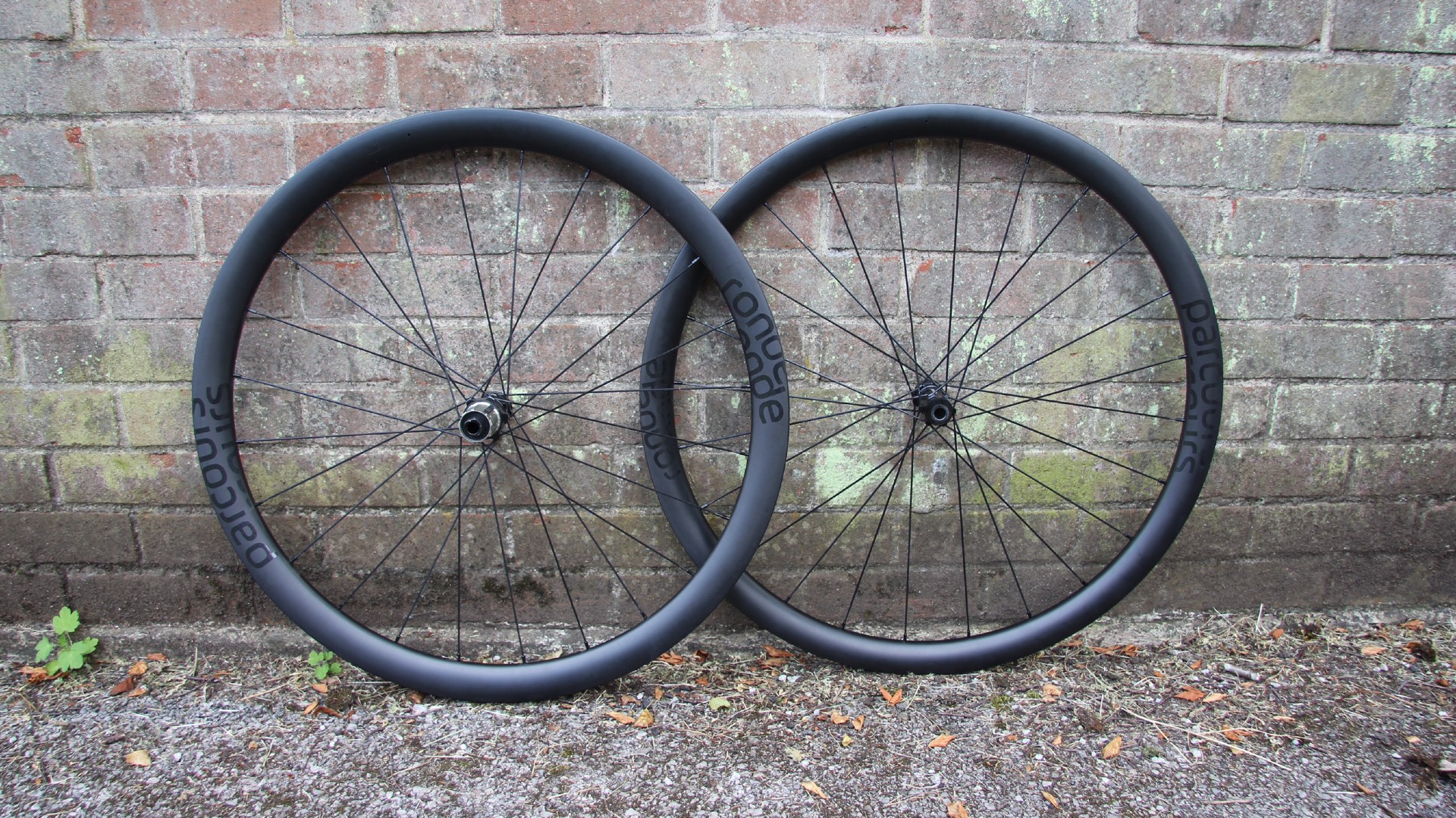
Our expert review:
There's very little not to like about these Parcours wheels. In fact, we gave the Ronde full marks when we reviewed them - for a mid-price wheelset it's got an impressive combination of low weight, great ride quality, aerodynamics and adaptability to road or gravel riding.
There's a differential rim depth and profile front and rear to cope with the different needs - stability at the front and power transfer at the rear, with the same 23mm internal width for both. Rims are tubeless compatible, although the hooked bead means that they can be used with a wider range of tyres than a hookless design.
Parcours Wind Tunnel tests its wheels and says that although less aero than the deeper Parcours Strade, the Ronde wheels are still best in class for their depth.
Read our full Parcours Ronde wheelset review
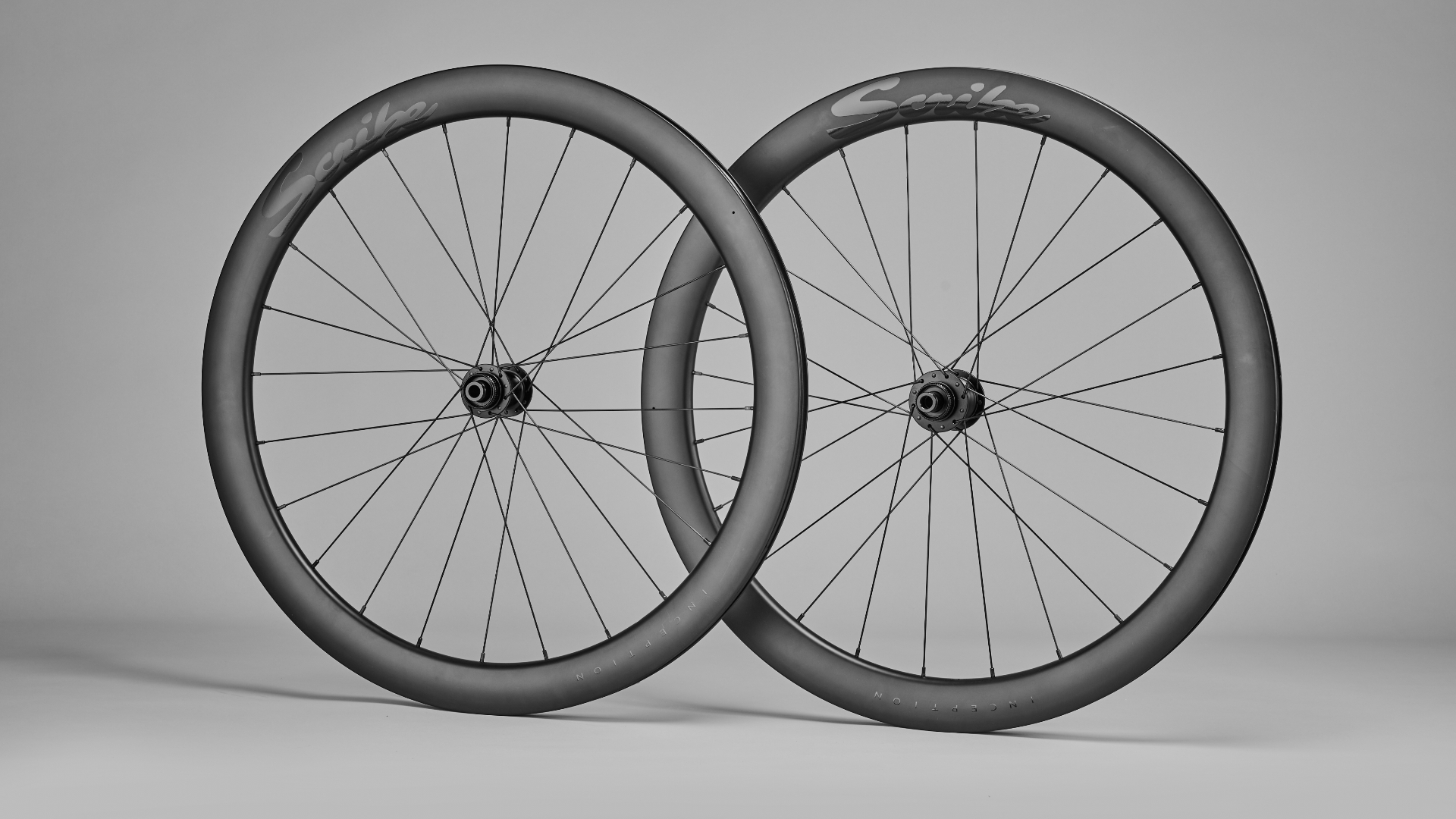
Our expert review:
It has been hard for some time now to make justifications for upgrading either stock wheel or a wheel that may be a couple of years old when a big chunk of the mid-depth market now offers very similar specifics and attributes. Most offer decent aero performance, fall within a certain weight range, and have pretty good durability across the board.
That is where the Scribe Inception 50 + makes a compelling case for your consideration. Coming in at under 1400 grams and under £700 on paper, they look like a handsome offer.
On the rough roads of the UK countryside, I was pleasantly surprised by their performance. Despite their 50mm depth, the rounded profile held speed well and didn’t get caught in crosswinds all that much. Their low weight made them agile and never held me back on the rolling terrain and short, punchy climbs of Oxfordshire.
Where the difference comes over some of the more expensive wheels I have tested, and indeed of the ones that feature in this guide, is the Inception's lateral stiffness. A mix of T700 and T800 fibres makes up the inception rim, which makes them light but lacks a bit of snap. If youare accustomed to even older Zipp or Enve products, you might find this area lacking a bit.
That should not take away from the fact that the Scribe wheels are brilliant. I fitted them to a Giant Contend SL, which I had on test, and it happens to be an excellent budget alloy road bike; they revolutionised the ride.
Read our full Scribe Inception 50+ review
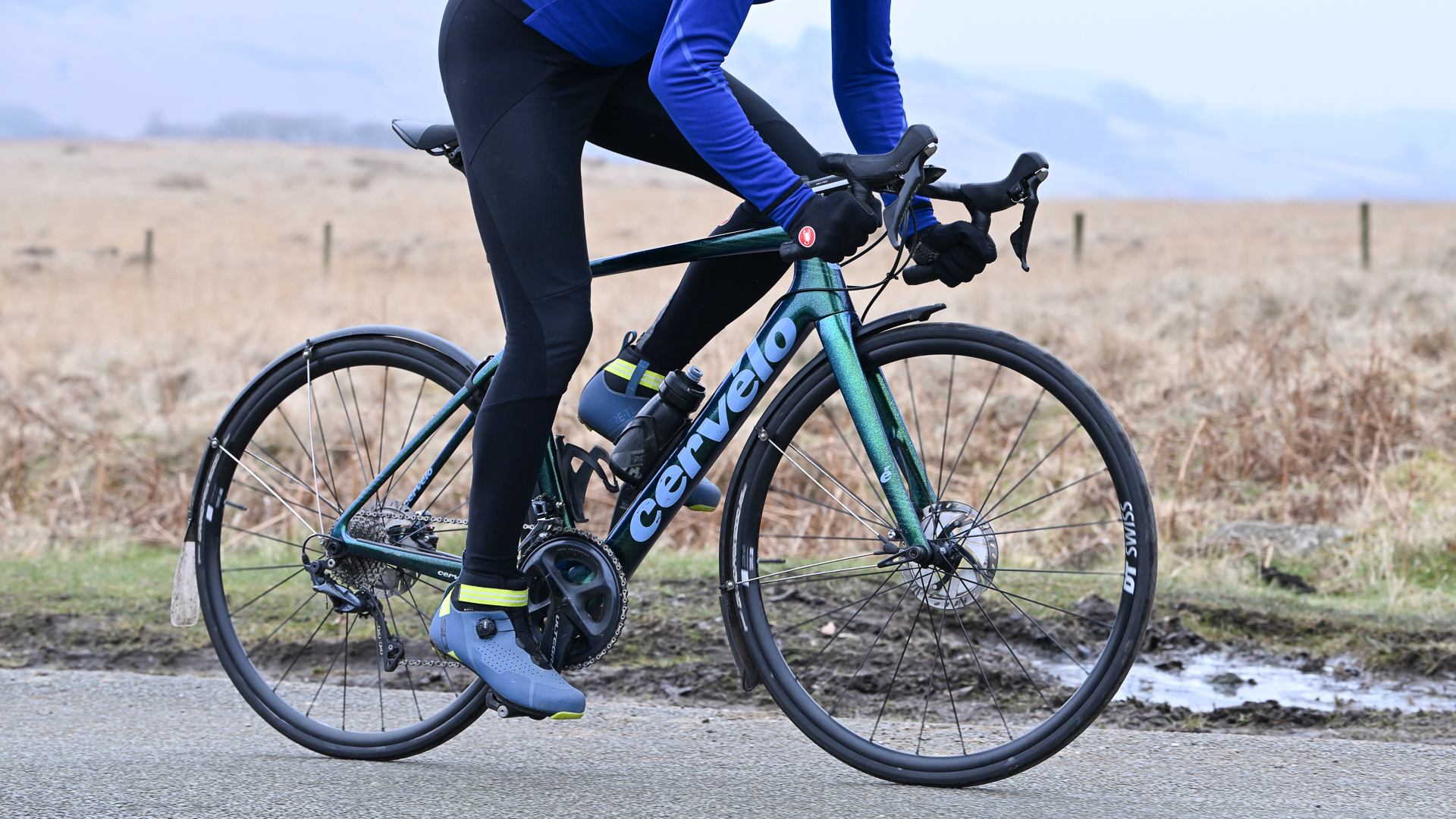
Our expert review:
With carbon fibre wheels becoming so affordable, and wheelsets like the Scribe Inception 50+ offering such good performance at these prices, is there still a place for shallow, aluminium wheels?
The DT Swiss ER 1600 Splines certainly make a compelling case for riders to still consider aluminium wheels as an upgrade or alternative, depending on your requirements.
While nothing stands out immediately about the 1600s, they aren't exceptionally light, at you guessed it, 1657g/3.3lbs, they aren't wide, in fact more on the narrower side of modern wheels with a 22mm internal width, and they feature DT Swiss's most economical 350 hub and ratchet system.
Based on this, I think you can forgive me for not expecting much from the ER 1600s, especially after testing some Mavic Cosmic S 42mm carbon wheels. More fool me!
They felt light and had a very unexpected turn-off speed, which persisted throughout testing, and I was certainly grateful for the shallow profile when a Peak District wind picked up.
Let’s not get carried away, though - I’m not going to be swapping out my aero carbon wheels anytime soon. However, the Splines' performance certainly exceeded my expectations, making a strong case to choose a good aluminium wheelset over a lower-end carbon one.
Read our full DT Swiss ER 1600 Spline review
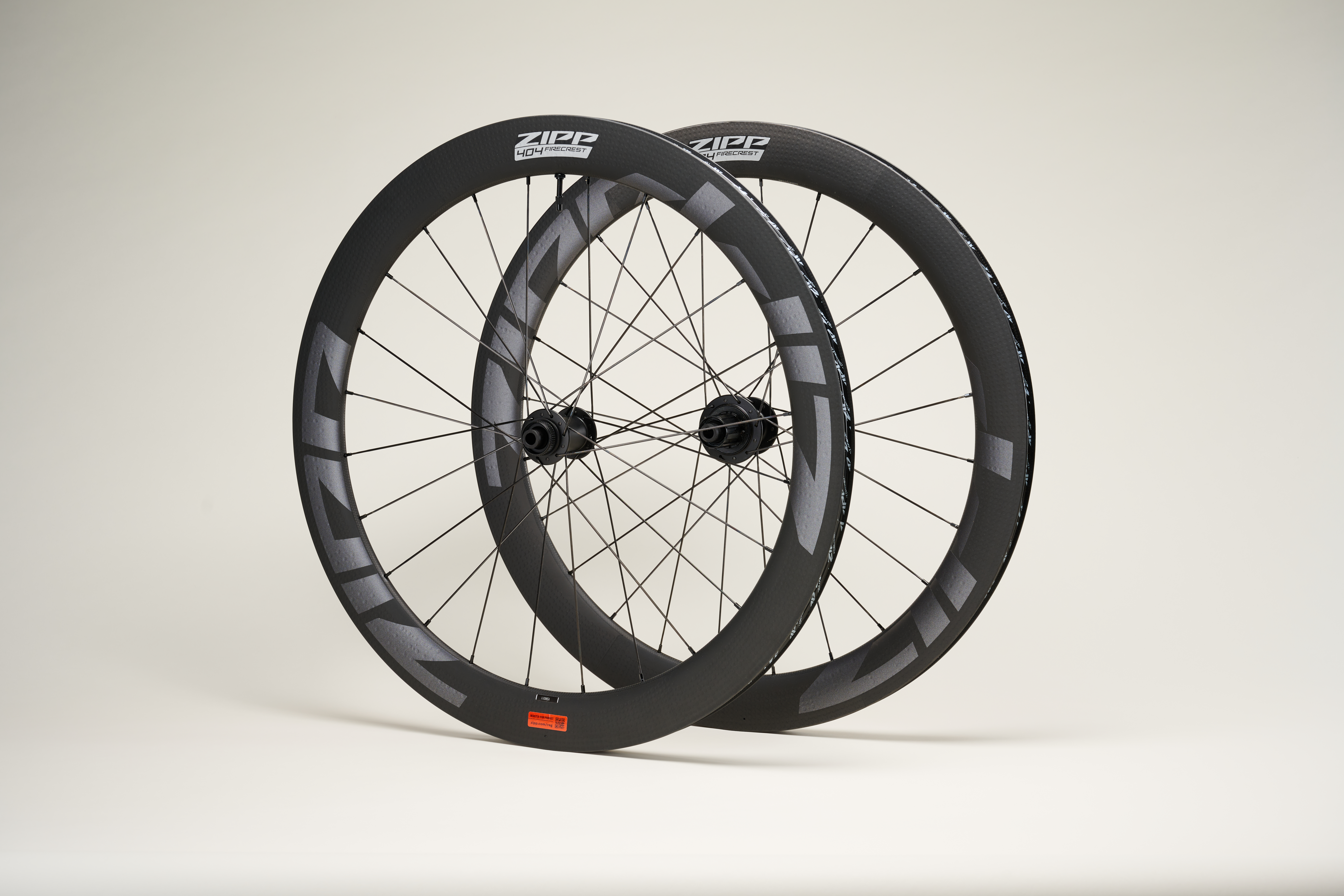
Our expert review:
The wheels use Zipp’s ABLC™ Sawtooth™ Technology – specifically placed dimples on the rim that are claimed to improve aero efficiency. Zipp’s Total System Efficiency (TSE) wheel design is also implemented, apparently resulting in a 4w saving compared to the previous Zipp 404 Firecrest thanks to better vibration dampening and aero features.
The hookless setup worked perfectly with the Pirelli P Zero RS Race TLR 28mm tyres, which were both easy to put on and also interfaced nicely with the rim to produce a very smooth profile with no bulging. Being hookless, I was limited to ~70psi, lower than I usually use. This led to a feeling that was more plush rather than on the rails, which is more comfortable and by most science is faster as well. Zipp has a pressure calculator, and using that I was recommended 58.7 front and 62.4 rear. I did try this, and it just felt, for lack of a better term, floppy. I used my preferred 70 rear and 65 front for the remainder of testing.
What I really loved though was the dialled-in cornering, the combination of hookless rim profile and P Zero tyres may have aided this. One area that certainly helped with the superb cornering stability was the spoking pattern. Front and rear, both sides feature a 2-cross lacing pattern along with 24 spokes on each, which results in superb lateral stability as well as great performance under braking and acceleration.
Weight-wise, the wheels are nothing exceptional, and they are not the most spritely wheels to accelerate. However, the wheel stiffness helps keep the acceleration in line with lighter wheelsets in the group test. It’s only on the steep inclines that weight becomes truly evident, but for most rides, this will be countered by their aero performance on lesser slopes, flat ground and descents.
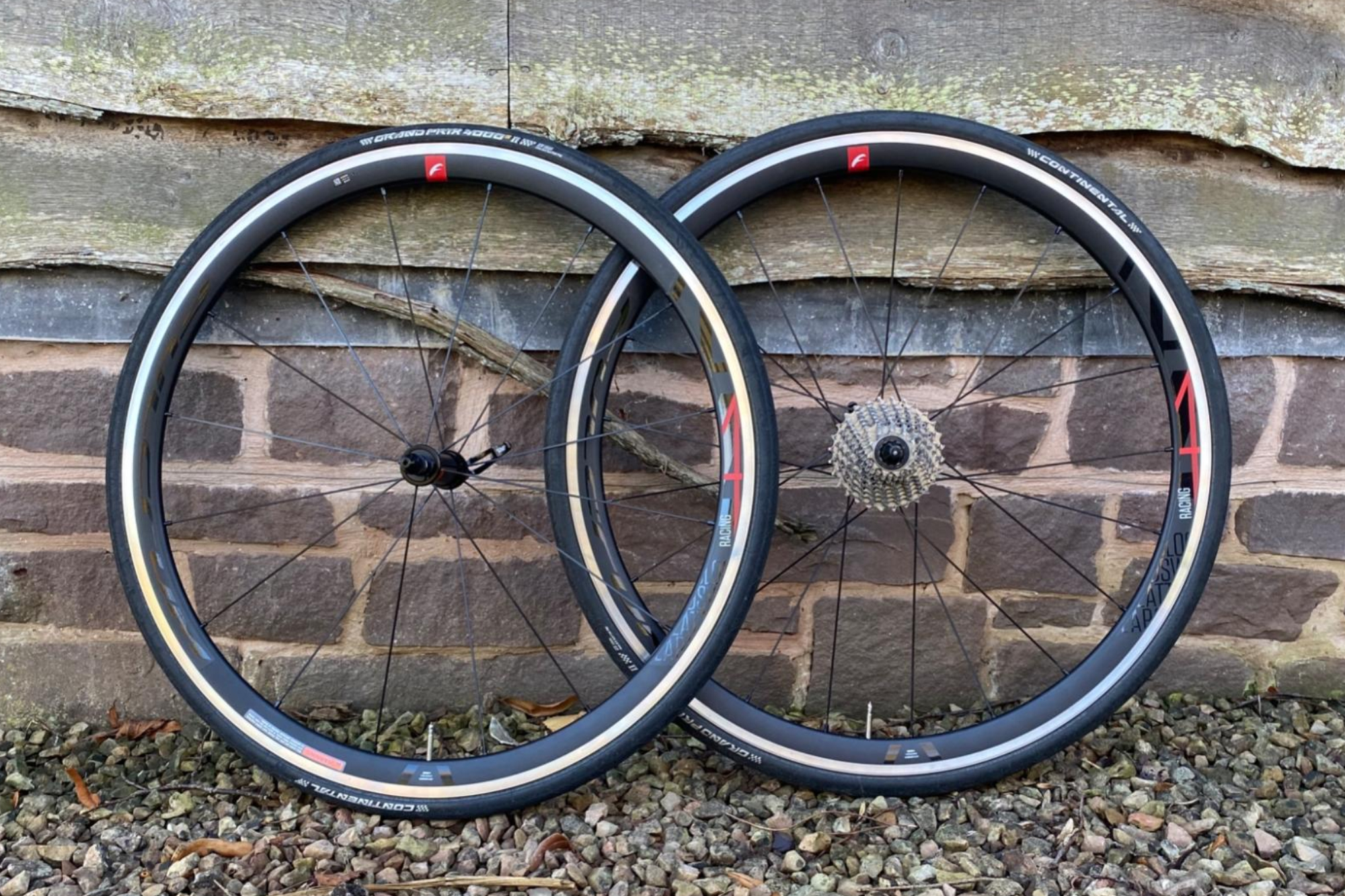
Our expert review:
The Fulcrum Racing 4 C17 is an aluminium rim-brake wheelset which combines a reasonable weight - at 1,727g - with a reasonably deep section 35mm rim for improved aerodynamics.
These wheels do fare very well when it comes to stiffness. Even when setting brake clearance as tight as I dared there was no lateral flex or brake rub when cornering at speed to sprinting out of the saddle maximally. The braking was also brilliant, for rim brakes, and amongst the best I have used, giving greater confidence when descending.
However, the narrow rim width does limit the rolling resistance performance of these wheels significantly compared to other wheels with wider rims that are optimised around chunkier tires. Comparing a pair of 23mm tires on the Fulcrum Racing 4 C17 directly to a set of wheels shod with 27mm tires, the difference in rolling resistance was noticeable - with the total system weight still being close enough as to be unnoticeable .
Value-wise, these wheels are competitively priced against its rivals. Some of the other wheelsets come in at around 100g lighter, however they are mostly 24mm deep and also more expensive. With that weight difference feeling fairly negligible and the aerodynamic gains of a deeper section wheel being more beneficial across most terrains, the Fulcrum Racing 4 C17 do represent a solid choice.
Read our full Fulcrum Racing 4 road wheelset review

Our expert review:
Zipp wheels are expensive, so the price of Zipp's 303S wheelset is a pleasant surprise. Like Zipp's other latest wheelsets, they have a wide internal rim bed and hookless bead. That lets you run lower pressures, but limits you to compatible tubeless tires of 25mm or wider only and a maximum of 72psi. You also need to look out for tire clearance, if you've got a tight frame.
Zipp says that, aerodynamically, the 303S wheels are almost the match of its much more expensive 303NSW and they feel fast, while the wide contact patch from the 23mm wide rims inspires cornering confidence.
Read our full Zipp 303S road bike wheelset review
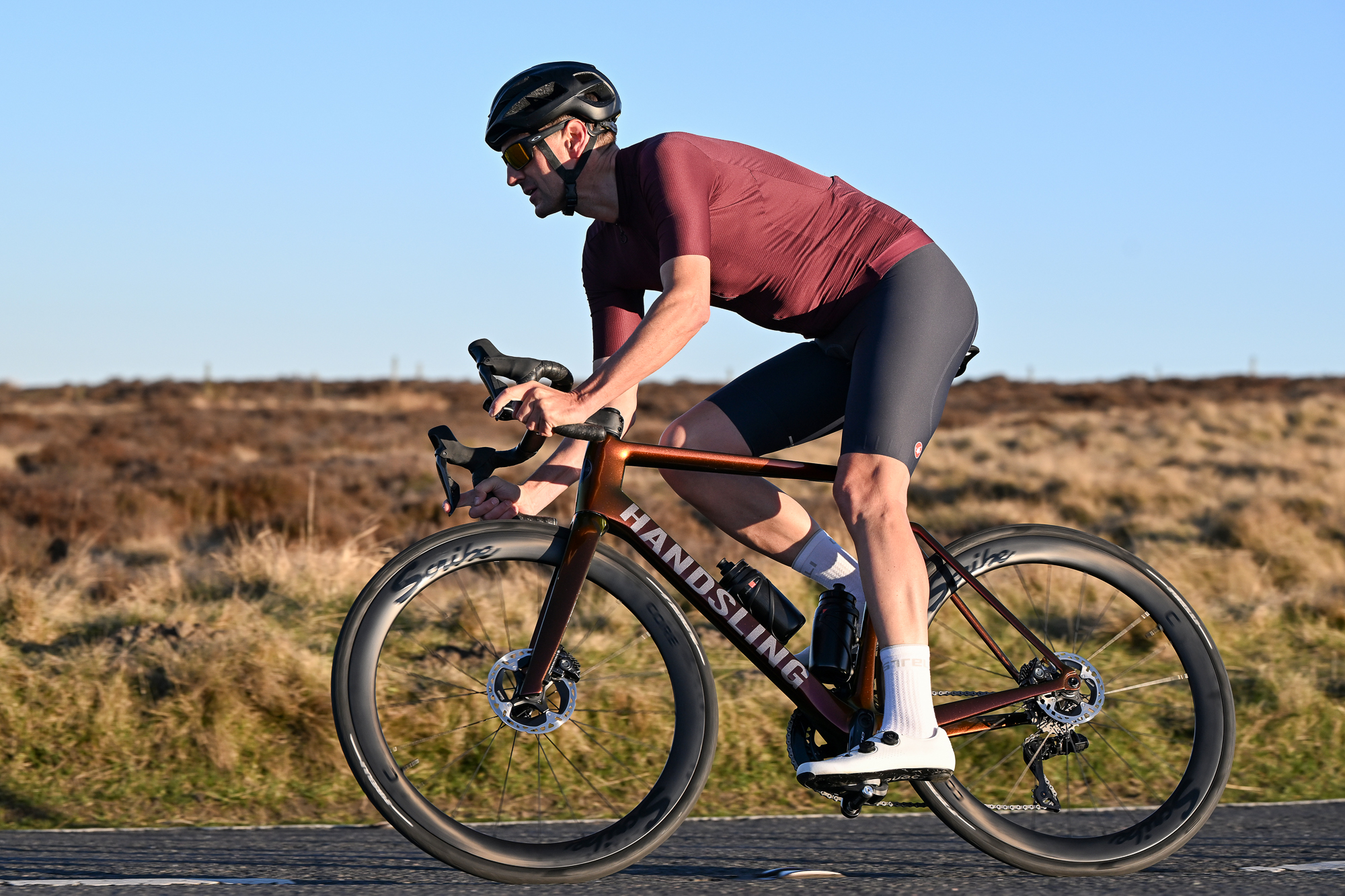
Our expert review:
With the wide adoption of disc brakes, bicycle wheels have taken some giant leaps forward in recent years. They are wider, faster, accept big tyres, offer incredible durability and are not too heavy either.
The Scribe Core Sl+ 50 offers an enticing blend of aero, low weight and affordability. I wanted them to be brilliant given their RRP, and I was not disappointed!
At 1,376g/3lbs, they are pretty light. They feature a mixed internal width, with the front being 24mm and the rear 21mm, to optimise aero performance. This was particularly surprising, given that these wheels had a hooked rim, which made this tester very happy.
Combined with a stiff T1000 carbon construction, this translated into a ride feel that quickly dispatched with many Climbs and descents; there was what seemed like an undiminishing urgency and efficiency transferred to the blacktop. This is supported by a recent independent wind tunnel test which suggests Scribe have done an incredible job and has dispatched the competition at considerably higher costs.
It is hard to find much wrong with the Scribes, especially when you consider what they cost. If I were pressed, I would say that they are stiff. While this translates to the excellant performance, the rough roads here in the UK did catch me out a few times and they did bounce me around a bit.
Read our full Scribe Core SL+ 50 review
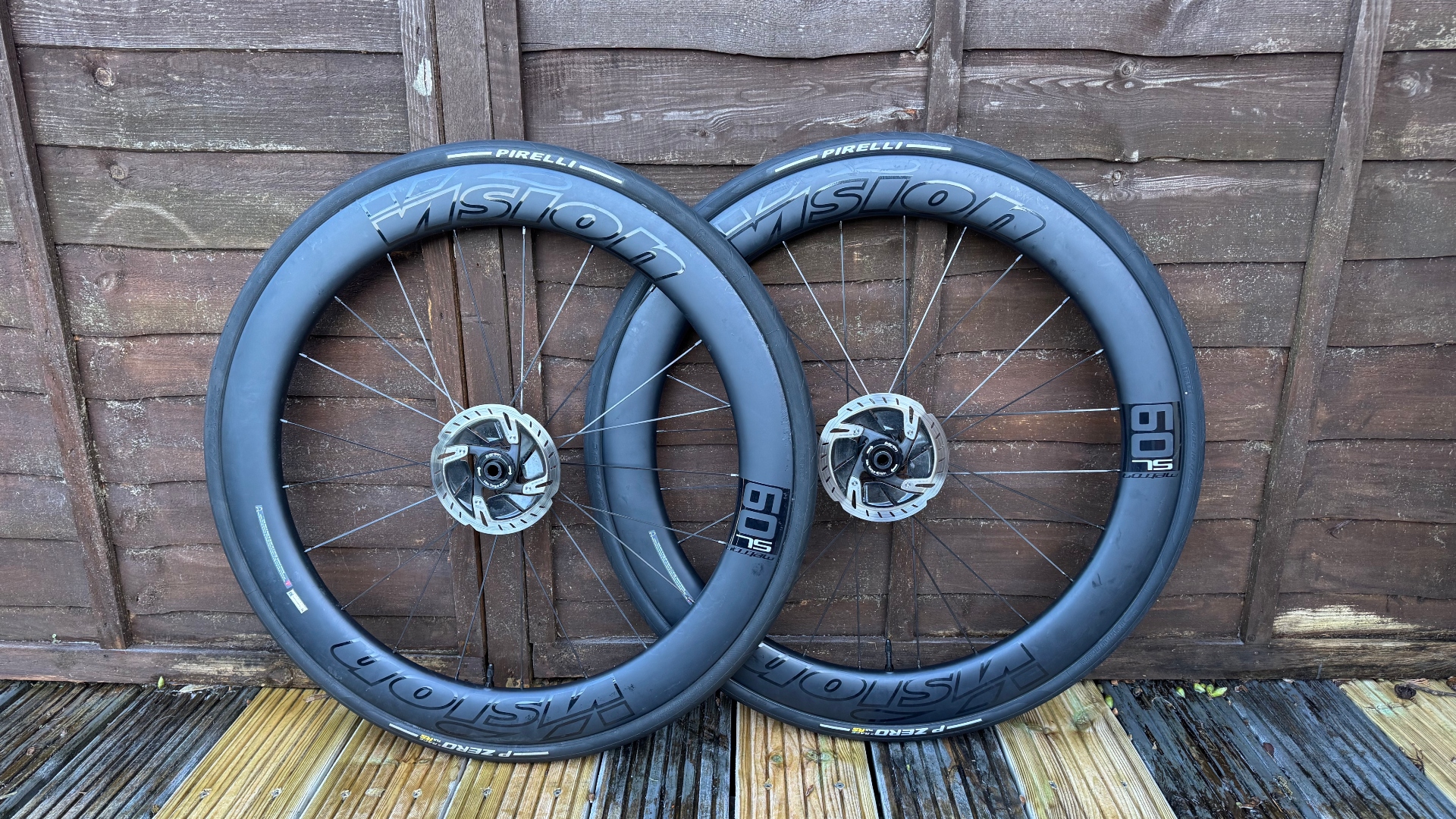
The Metron SL 60's are a 'Vision' in black
Our expert review:
The Vision Metron 60 SL is Vision’s top-of-the-line deep-section road race wheel, featuring its latest technologies. The rims have a 21mm internal width matched with a 29mm external width, which bulges to 30mm further down the rim for improved aerodynamic performance. They are a hooked rim, which I'm still a fan of as a heavier rider, but there are no hookless options.
Spoke lacing is asymmetric on both the front and the rear, with multiple cross-lacing patterns to optimise lateral and torsional stiffness. This has worked perfectly, with the wheels feeling lightning fast to get up to speed and rock solid when cornering and braking. The new 72-tooth ratchet engagement drive also helps with this rapid acceleration while reducing the total number of moving parts, which promises better longevity and serviceability.
At 1603g, they aren’t the lightest 60mm deep sections available, but their high stiffness contributes to excellent climbing ability. Aero performance is difficult to quantify out on the road but they feel as fast as any other 60mm wheelset I have tested in the last year. Their crosswind performance is exceptionally stable though, even exhibiting a noticeable sail effect. Priced at £2049.99, they remain expensive, but within this price range, they excel across the board without compromising performance in any area. Nothing stands out as truly exceptional or class-leading, yet there are no glaring negatives, which is a challenging feat to accomplish. They are a true jack of all trades, albeit closer to a master in some areas.
Read our full Vision Metron SL 60 wheelset review
Choosing the best road bike wheels can be quite a minefield. There are numerous standards, widths, and depths to consider, not to mention tyre compatibility, materials, and the various advantages and disadvantages of each option.
This single piece of advice applies to nearly all bicycle components, but it is never more true than with wheels. Spend wisely and extend your budget as far as possible. Aside from your frame, wheels arguably offer the greatest performance upgrade you can make.
Like with so many things, a direct correlation exists between how much you spend and the performance gained. If we were to break it down, choosing the best road bike wheels comes down to striking a balance of these three key areas:

Your bike probably came complete with clincher wheels, and for good reason. Clinchers are the most common type of bike wheel currently available, and they are defined by the type of tyre they use. This is where the tyre has an open section and a bead that locks or is forced using pressure, keeping it in place on the rim.
There are two types of clincher rims, hooked and hookless:
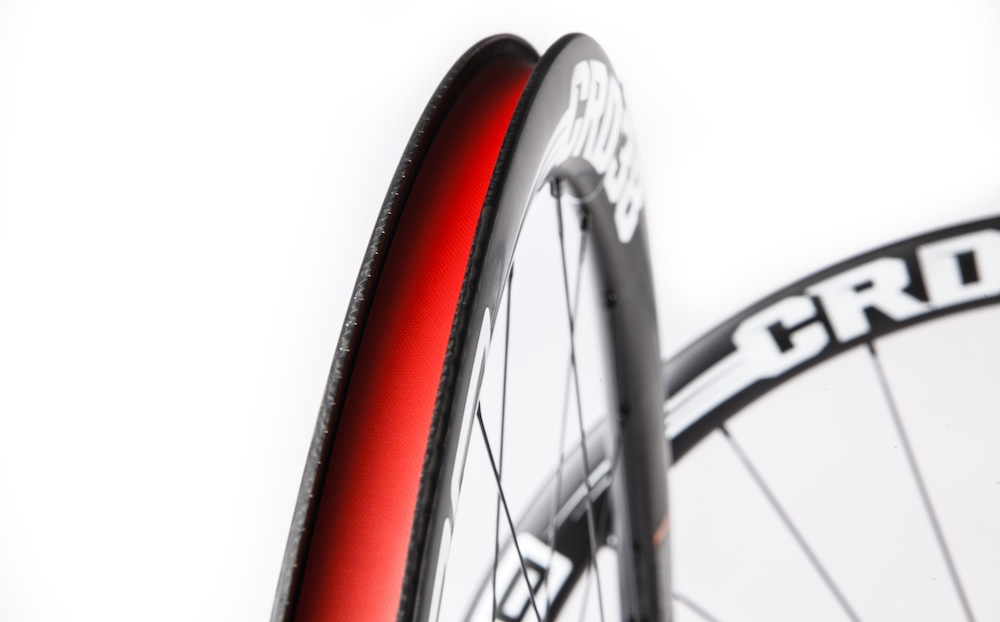
Hooked Clinchers are exactly as they sound. The sidewall of the rim features a hooked end that faces inwards toward the centre of the rim. This allows the tyre's bead to be pushed up into the hook, holding it secure.
Hooked wheels tend to be heavier, though, due to the increased amount of material used in the higher sidewall. This tradition dates back to when most bike brakes were applied to the rim. While this design style offers great tyre security and ease of removal and fitting, it is hard to engineer very light and high-performance wheels.
You can still see this design on many modern disc brake wheels, to a point, but with the shift to tubeless on the road, there is less need for it and more benefit from wheels featuring a hookless clincher design.
Advantages
It is easy to repair punctures just by carrying spare inner tubes
Easy to change tyres, can be done in minutes
Clincher tyres are typically cheaper
Many can be set up tubeless or with a tube
Excellent tyre security
Disadvantages
Typically heavier
Higher rotational weight
Less aerodynamic
More complicated and higher cost to manufacture
More susceptible to impact damage
The idea of rims with no/very little side wall is nothing new, with cyclists using tubular wheels for decades. However, this new wave of hookless rims promises all the convenience of a clincher rim with many performance gains traditionally offered by tubular.
Hookless rims have a very short sidewall to the rim; imagine taking a standard hooked rim and just cutting off the top third. Hookless rims rely heavily on a strong, tight bead in conjunction with the pressure inside the tyre to hold it to the rim.
This style of rim does have limitations, though. For example, many are tubeless only, meaning you cannot just chuck in a tube to get home. Additionally, not all tubeless tyres are compatible with hookless rims, which can make tyre shopping quite tricky.
Advantages
A cleaner transition between the rim and the tyre – more aero
The design allows for wider internal widths for better tyre profiles
Simpler manufacturing means a stronger rim from better carbon compaction and a more even distribution of resin
More even resin distribution and carbon compaction also means a lighter rim as less material is needed overall
Less waste during production
Higher resistance to impacts
Disadvantages
Not all tubeless tyres are compatible with hookless
Many are not able to use tubes
Risk of a tyre blowing off the rim with the wrong combination or overinflation
Maximum tyre pressures mean that those at the higher range are more susceptible to air temperature changes and potentially not ideal for heavier riders at all
ETRTO standards mean that some tyre widths will not be compatible with wider rims; for example, 25mm internal widths can no longer run anything smaller than 30mm
Before the invention of clincher tyres, tubular wheels were the only option available. Today, they’re a rare sight away, even in the pro peloton, with almost all the teams now running tubeless.
Tubulars, or 'tubs' for short, are tyres that do not require sidewalls on the rim; in fact, the rim of a tubular is nearly flat. This means tubular rims are very light. The tyre which is round with no opening, houses the inner tube and is glued or taped to the rim.
As the tyre encloses the inner tube, it makes them almost impossible to fix, and why, for everyday riders, they were abandoned decades ago. Thanks to their shape and the materials used (typically a cotton casing, with a rubber track glued to the outside), the tyres are incredibly supple and fast, meaning you can run them with very high pressures with very few drawbacks. Making them popular among time trialists and track cyclists.

Advantages
Lighter rims
Strong rims
More supple tyres that can be run at high pressure for decreased rolling resistance without compromising comfort
Can be run at very low pressures, without fear of pinching, even run flat for short distances
Disadvantages
Less easy to fit than clinchers
Repairing a puncture is rarely possible, and you can't fit a tube to get home
limited 'off the shelf' options
Tyres sidewalls are more exposed, making them more susceptible to damage
Most wheels feature a Shimano HG freehub body designed for 11-speed cassettes. But don’t worry if you’re still running less than this, as you can use a cassette spacer. These spacers are often included with the wheels, but if you are unsure, check with your local bike shop.
It can get more complicated for those running 12/13-speed or Campagnolo, as both SRAM, Campag and Shimano have two freehub body options depending on the groupsets age. Luckily for SRAM users, you can upgrade to XDR with a spacer if you have an older XD. For Campag, their switch to N3W freehub standard and 13-speed means, depending on the wheel manufacturer, depends on compatibility, as some don't make adapters. Shimano Microspline for the road is backwards compatible with standard HG. However, it is not the Microspline used on MTB and their GRX gravel wheels and cassettes.
Sure.
Nobody's stopping you from using different wheel brands on the front and back of your road bike. In fact, this is quite common on the track and with time trialists, who often use solid disc wheels in the rear, which not every brand produces.
Absolutely. In fact, this is advised to help with stability in crosswinds. It's commonplace to run a slightly shallow wheel in the front to better control your bike and a deeper wheel in the rear to maximise aero performance; some brands even offer mix-and-match depth options, like Hunt's aerodynamicist range of 52, 62, and 82mm wheels.
Like all the products we test here at Cycling Weekly, we put in serious miles on as wide a variety of courses and terrains as possible to determine a wheel's performance and offer valuable insight into each review.
Wheels differ a little when we start to examine their aerodynamic performance, though. As much as we would love to put every wheel in a wind tunnel, this is not feasible for several reasons. First, different tunnels and conditions return different results, and the time and cost of such testing could be unsustainable. However, what we do, is partner with experts like Andy Turner on a regular basis to help review wheels. Andy, for example, is a sports scientist who has spent many hours working with UCI teams on the road and in the wind tunnel to optimise performance. Having been a racer himself and spent time on a number of different teams and riding different component brands, he is ideally placed to offer opinions on this area based on his findings out on the road.
In all of our reviews, though, you will find that much care is taken to examine the areas that will affect almost every rider. These include how easy tyres are to fit, their compatibility, and their performance in crosswinds, uphill, and under braking.
Visit our How We Test Products page for more on the Cycling Weekly team and how we conduct our testing.
There is a lot of tech jargon associated with wheels; here's a quick guide to the terms you might encounter.
Hub Axle: There are two kinds of axle when discussing wheels; there is, firstly, the axle housed within the main body of the hub; this is what the bearings spin on, and it is important to the correct fitment based on your frame requirements.
Frame Axle: there is also the axle, which you insert through the hub to attach the wheel to your frame. Depending on your bike's standard, this is generally called the quick-release or thru-axle.
Axle width and standard: Road bikes have multiple axle spacing standards. Quick-release wheels usually run on 100 mm-wide front axles and either 130 mm-wide rear axles, which are typically used for rim brake bikes, or 135mm if a bike is designed for QR wheels for disc brakes. The axle is 9mm in diameter.
Wheels and frames with thru-axles usually have 100mm spacing at the front axle and 142mm at the rear, although a few road/gravel bikes use Boost spacing, which is 110mm front and 148mm rear. Thru-axles on road bikes are typically 12mm in diameter, although some older models may have a 15mm front.
Dropout: The dropouts are part of the frame to which the wheel sits in between. Depending on your frame standard will determine how the wheel fits in. The axle will sit in the dropout, which will have an open section for a quick-release wheel. For thru-axles, the dropout will be closed, and the wheel will rest between the two sides.
Hub: The hub is the centre of the wheel that rotates around the axle. It houses the bearings and drive mechanism, which transfers energy into forward movement. The hub also connects to the rim via spokes.
Freehub: The freehub is the part of the rear wheel to which the set of gear sprockets is attached. It turns your energy into forward movement and allows you to be freewheel. The freehub and the mechanism in which it operates are what give the wheels their trademark clicking noise.
Bearings: The hub turns on the axle via bearings. These may be loose ball bearings rolling on a cup and cone system or cartridge bearings, which are more common nowadays. Loose bearings are user-serviceable, whereas cartridge bearings need to be removed and replaced in their entirety when they become worn.
Spokes: Spokes connect the rim to the hub and provide strength and shape to your wheel. Most are made of steel, but more expensive wheelsets occasionally use carbon spokes to reduce weight. Spokes can also be engineered to reduce weight, add aerodynamic performance, and even provide additional comfort.
Nipple: Nipples are usually at the rim end of the spoke. They are effectively tightened nuts to add tension to a wheel, giving it its shape and strength. Nipples may be brass or aluminium. The former is heavier but less prone to corrosion.
Rim: The rim is the outer circular part of the wheel and is what your tyre fits to. Most rims are designed for clincher tyres, although if you run tubular tyres, you'll need a different-shaped rim. Clincher rims subdivide into those designed only to be used with tyres with inner tubes and those that are tubeless-ready. Many rims can be used with both.
Hooked Rims: Tubeless rims are further divided into hooked and hookless designs. Hooked rims can be used with tubed or set up as tubeless. They design features a hook which the tyre can grab onto when pressure is added to allow for a secure fit and quality seal.
Hookless rims do what they say on the tin. They are rims without a hook into which the tyre's bead can lock. Hookless is a newer technology in cycling, and you, the rider, must check your tyre'ss compatibility with hookless rims before fitting them.
Braking surface: Rim brake wheels will have a shiny, machined surface around the outside of the rim to which the brake pad is applied to stop your bike.
Centrelock is a standard for fitting disc brake rotors to the hub of your wheel. The disc's rotor has a centre spline that slides onto a matching spline on the hub shell directly. A large lock ring holds it in place.
Six-bolt is the other most common disc rotor fitting system. In this system, the rotor is fitted to the hub using six small bolts. These are usually M4 T25 Torq bolts, which thread directly into the hub shell and hold the rotor against a large flange.